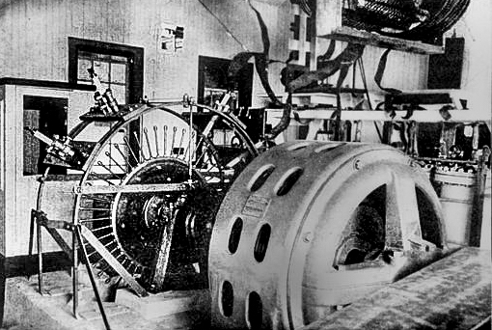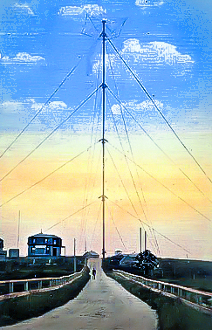Reginald Aubrey Fessenden (October 6, 1866 ➙ July 22, 1932) was a Canadian-born inventor, who did a majority of his work in the United States and also claimed U.S. citizenship through his American-born father. During his life he received hundreds of patents in various fields, most notably ones related to radio and sonar.
Fessenden is best known for his pioneering work developing radio technology, including the foundations of amplitude modulation (AM) radio. His achievements included the first transmission of speech by radio (1900), and the first two-way radiotelegraphic communication across the Atlantic Ocean (1906). In 1932 he reported that, in late 1906, he also made the first radio broadcast of entertainment and music, although a lack of verifiable details has led to some doubts about this claim.
In 1900 Fessenden left Pittsburgh to work for the United States Weather Bureau, with the objective of proving the practicality of using a network of coastal radio stations to transmit weather information, thereby avoiding the expense of the existing telegraph lines. The provisions of his contract called for him to be paid $3,000 per year, and provided with work space, assistance, and housing. The agreement gave the Weather Bureau access to any devices Fessenden developed, but he would retain ownership of his inventions. Fessenden quickly made major advances, especially in receiver design, as he worked to develop audio reception of signals. His initial success came from the invention of a barretter detector, which was followed by an electrolytic detector, which consisted of a fine wire dipped in nitric acid, and for the next few years this latter device would set the standard for sensitivity in radio reception. pages open in new browser window
As his work progressed, Fessenden also developed the heterodyne principle, which, to aid reception, used two closely spaced radio signals to produce an audible tone that made Morse code transmissions much easier to hear. However, heterodyne reception would not become practical for a decade after it was invented, because it required a method for producing a stable local signal, which would not become available until the development of the oscillating vacuum-tube.
His most extensive work was in marine communication, in conjunction with the Submarine Signal Company. While there, he helped develop a type of sonar system, the Fessenden oscillator, for submarines to signal each other, as well as a method for locating icebergs, to help avoid another disaster like the one that sank Titanic. In these efforts, akin to his replacing spark-gap with continuous-wave radio transmitters, he had the company replace devices that rang bells with ones that transmitted a steady tone.
At the outbreak of World War I, Fessenden volunteered his services to the Canadian government and was sent to London where he developed a device to detect enemy artillery and another to locate enemy submarines. Other efforts included a version of microfilm, that helped him to keep a compact record of his inventions, projects and patents. He also patented the basic ideas leading to reflection seismology, a technique important for its use in exploring for petroleum, and received patents for diverse subjects that included tracer bullets, paging, television apparatus, and a turbo electric drive for ships.
An inveterate tinkerer, Fessenden eventually became the holder of more than 500 patents. He could often be found in a river or lake, floating on his back, a cigar sticking out of his mouth and a hat pulled down over his eyes. At home he liked to lie on the carpet, a cat on his chest. In this state of relaxation, Fessenden could imagine, invent and think his way to new ideas. Fessenden also had a reputation for being temperamental, although in his defense his wife later stated that "Fessenden was never a difficult man to work with but he was an intensely difficult man to play politics with." However, one of his former assistants, Charles J. Pannill, recalled that "He was a great character, of splendid physique, but what a temper!", while a second, Roy Weagant, ruefully noted that "He could be very nice at times, but only at times."
On the occasion of his death, an editorial in the New York Herald Tribune, "Fessenden Against the World", said: It sometimes happens, even in science, that one man can be right against the world. Professor Fessenden was that man. It is ironic that among the hundreds of thousands of young radio engineers whose commonplaces of theory rest on what Professor Fessenden fought for bitterly and alone only a handful realize that the battle ever happened... It was he who insisted, against the stormy protests of every recognized authority, that what we now call radio was worked by "continuous waves" of the kind discovered by Hertz, sent through the ether by the transmitting station as light waves are sent out by a flame. Marconi and others insisted, instead, that what was happening was the so-called "whiplash effect"... It is probably not too much to sat the progress of radio was retarded a decade by this error... The whiplash theory faded gradually out of men's minds and was replaced by the continuous wave one with all too little credit to the man who had been right...
In 1980, a Fessenden-Trott Scholarship was established at Perdue University's School of Electrical and Computer Engineering, in memory of Reginald Fessenden and his wife.
The plan was to conduct the transatlantic service using Fessenden designed rotary spark-gap transmitters. A 420 foot (128 meter) guyed antenna was constructed at Brant Rock, with a similar tower erected at Machrihanish in western Scotland. In January 1906, these stations made the first successful two-way transmission across the Atlantic, exchanging Morse code messages. (Marconi had only achieved one-way transmissions at this time.) However, the system was unable to reliably bridge this distance when the sun was up, or during the summer months when interference levels were higher, so work was suspended until later in the year. Then, on December 6, 1906, the Machrihanish radio tower collapsed in a gale, abruptly ending the transatlantic project before it could begin commercial service. (A detailed review in Engineering magazine blamed the collapse on sub-standard construction, due to "the way in which the joints were made by the man employed for the purpose by the sub-contractors to whom the work was entrusted by the Brown Hoisting Machinery Company" and "The only wonder is that the tower did not fall before."
In a letter published in the January 19, 1907 issue of Scientific American, Fessenden discounted the effect of the tower collapse, stating that "The working up to the date of the accident was, however, so successful that the directors of the National Electric Signaling Company have decided that it is unnecessary to carry on the experimental developments any further, and specifications are being drawn up for the erection of five stations for doing transatlantic and other cable work, and a commercial permit is being applied for in England." However, the tower collapse did in fact mark the end of NESCO's transatlantic efforts.
In the late 1890s, reports began to appear about the success Guglielmo Marconi was having in developing a practical system of transmitting and receiving radio signals, then commonly known as "wireless telegraphy". Fessenden began limited radio experimentation, and soon came to the conclusion that he could develop a far more efficient system than the spark-gap transmitter and coherer-receiver combination which had been created by Oliver Lodge and Marconi. By 1899 he was able to send radiotelegraph messages between Pittsburgh and Allegheny City, using a receiver of his own design.
![]() Rotary Spark Transmitter and the First Two-Way Transatlantic Transmission
Rotary Spark Transmitter and the First Two-Way Transatlantic Transmission

.jpg)

![]() Return to Radio Pictures
Return to Radio Pictures
![]() Return to MCRN Home
Return to MCRN Home